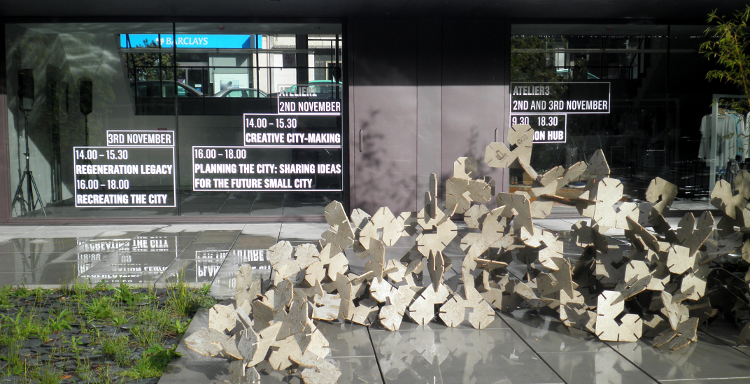
Cidade Campus & Open City: What have we learned?
Over the course of two days the Cidade (or City) strands of Guimarães 2012 gathered together a series of keynotes and workshops to animate ideas of innovation and openness in the future development of smaller cities in particular – representatives from across Europe and beyond (Brazil, Nigeria) brought their projects, experiences and opinions to generate debate.
Open City was represented by keynotes from Charlie Leadbeater, Marleen Stikker (from Waag Society), Greg Hadfield and Dick Penny & Clare Reddington, exploring the basis of their contributions to the project. In addition Tom Inns from University of Dundee created a model of open feedback to seek to draw out lessons and highlights for both Guimarães and also the other European Capitals of Culture, past and future, attending.
Across the Plataforma das Artes we installed the Future Guimarães film, the film documenting Give Me Back My Broken Night and also a selection of the Walking the Sky images from James Bridle’s workshop.
The real output of the event however was a series of connections and relationships generated through finding inspiration and reflection from other speakers, from Ricardo Lobo’s LCD project in Guimarães to Femi Longe’s amazing CC Hub in Lagos.
For more detail on the Cidade Campus see here: Cidade Campus Programme
Guimarães 2012 – so what did we learn?
Open City Guimarães 2012 has been at the same time diverse, dispersed and dynamic. Through our involvement with the European Capital of Culture we have had the opportunity to be part of a significant international event – so what have we learned?
We learned that technology both generates and enables transparency, and that transparency creates both a challenge and an opportunity for participation.
We learned that from the outliers of open source or Occupy, to the signifiers of social media, there is an increasingly held belief that a different approach, an open inclusive approach, provides a viable alternative to failing models.
And we learned that this open philosophy can be applied in many ways, strategic to practical, culture to government.
BUT we also learned that the challenge to hierarchies and embedded process will make widespread adoption of radical change slow, despite an international community of exemplars, and that in implementation everyone needs access.
We learned that difficult concepts need simplifying, and preferably demonstrating, openness implies widespread understanding.
We learned that technology can alienate unless you hide the wires and concentrate on the human effects and impacts. Complexity needs communication.
And we learned that passionate and interested people can catalyse a similar response once you make the connection and articulate a vision.
Over the course of the Guimarães 2012 Open City project we have commissioned a series of great thought leadership from a wide variety of contributors across a broad spectrum of subject matter – united by a common theme of expert analysis and clarity on the opportunity of Openness as a conceptual framework. Through films, theatre pieces and artist led workshops we have sought to animate these ideas, and crucially involve a local audience.
Taken together these contributions form a coherent and comprehensive exploration of the opportunity of openness in city development from conceptual framework to design philosophy, geography to governance. As well as residing on this site as a resource we will publish as a digital document shortly.
Two final learning points:
Understanding and working across differing professional and institutional cultures requires a fine balance between acceptance and challenge.
And that if you are in Tio Julio’s it is probably too late….
Mark Leaver

